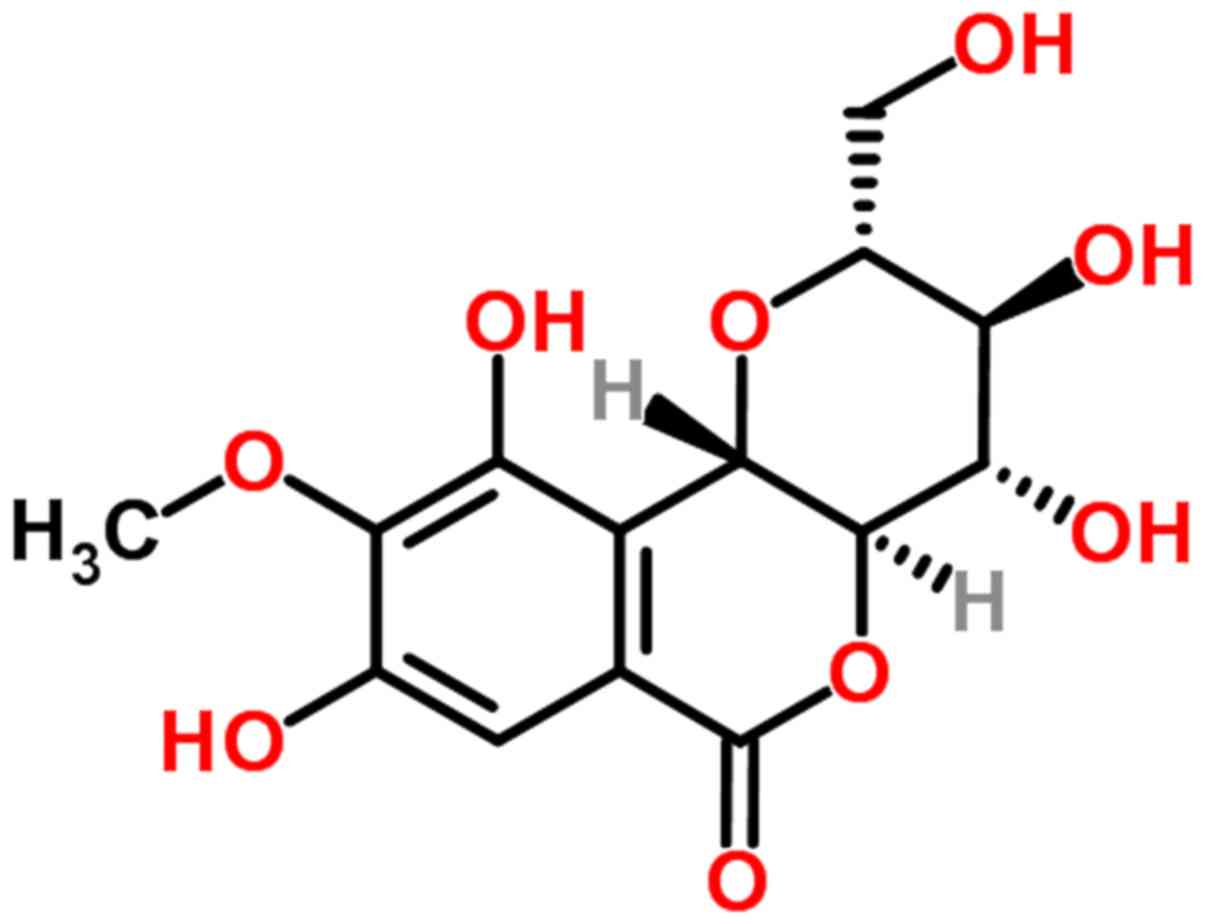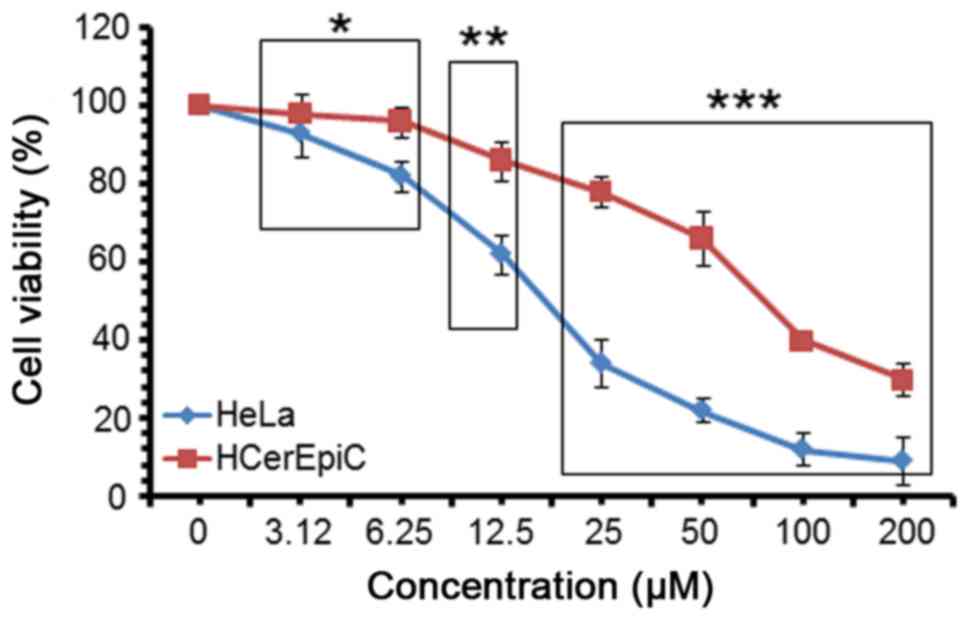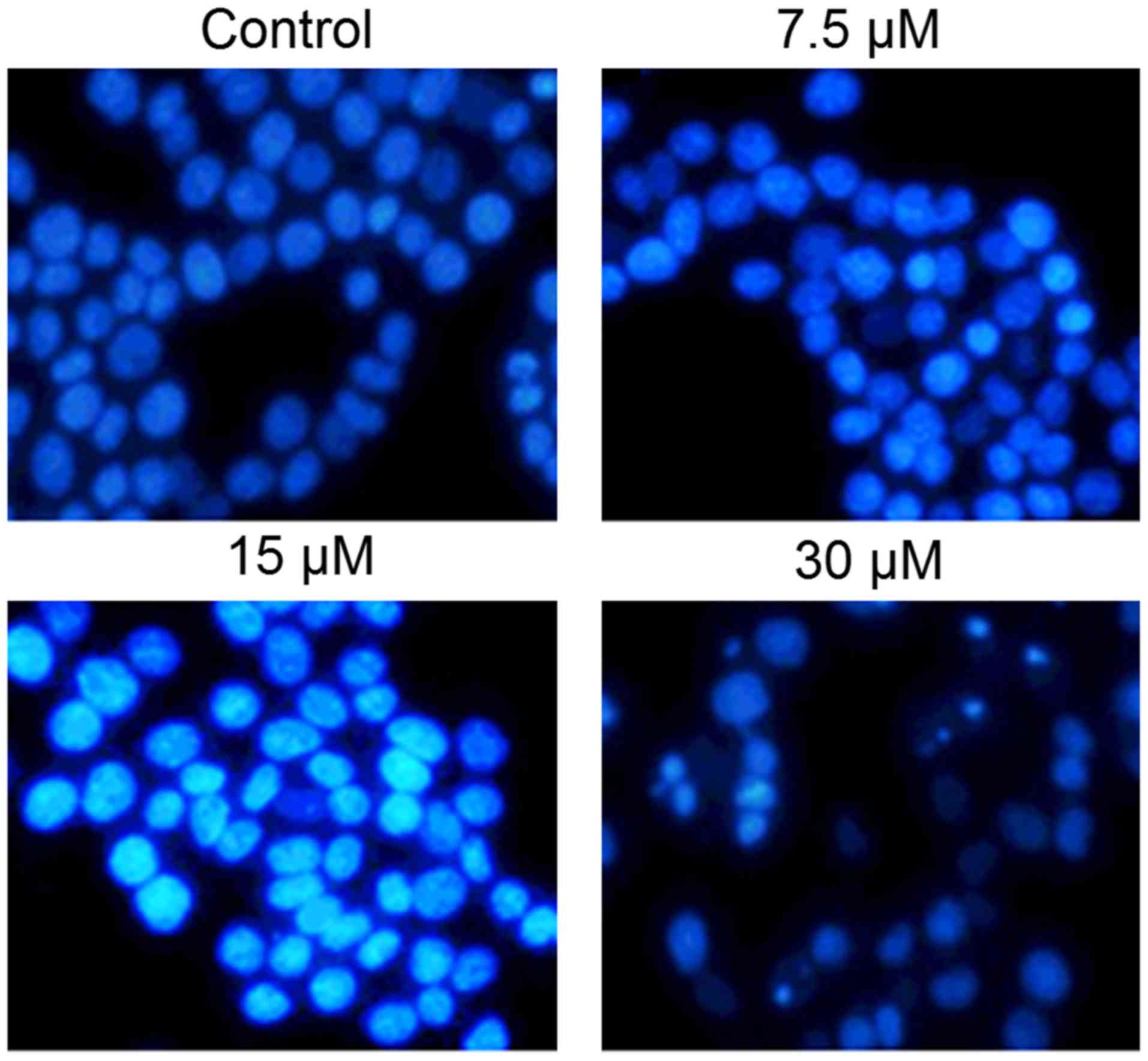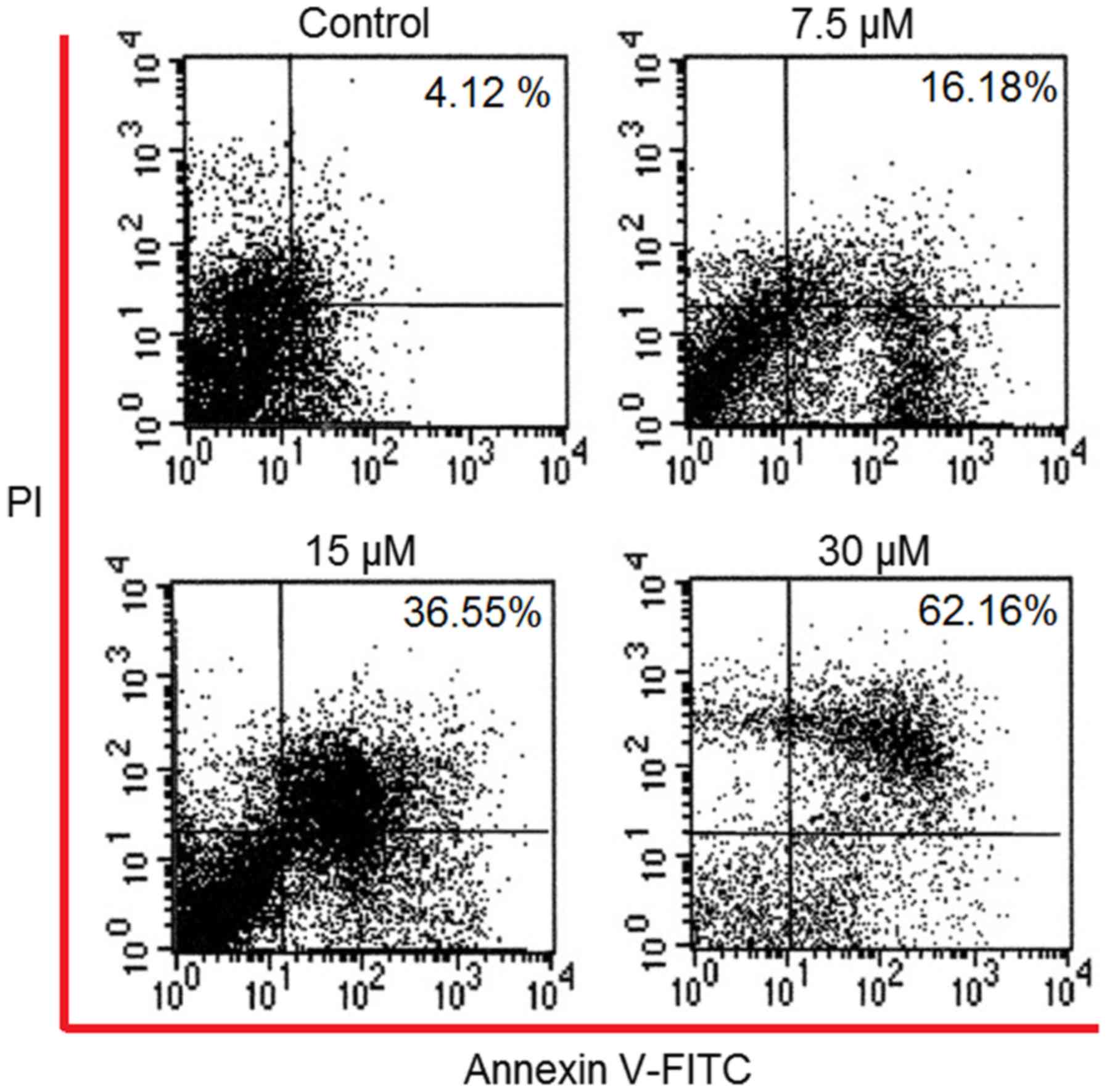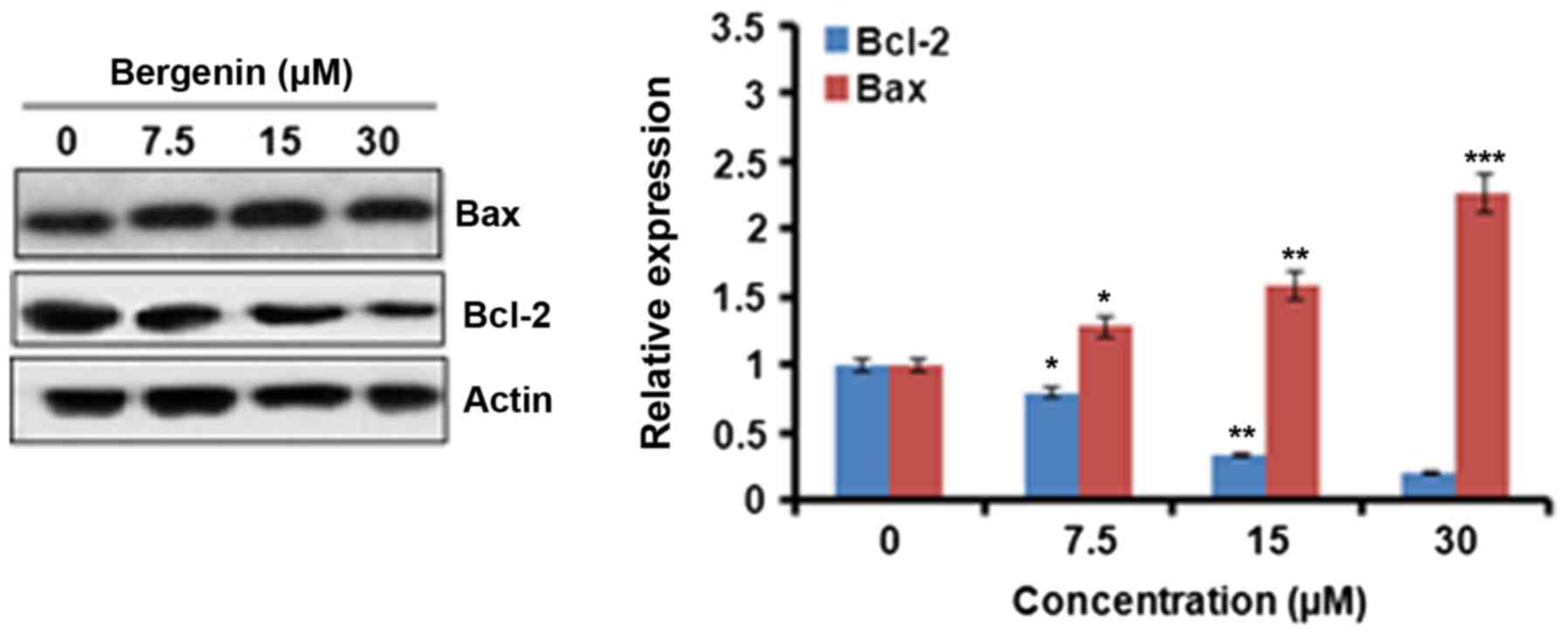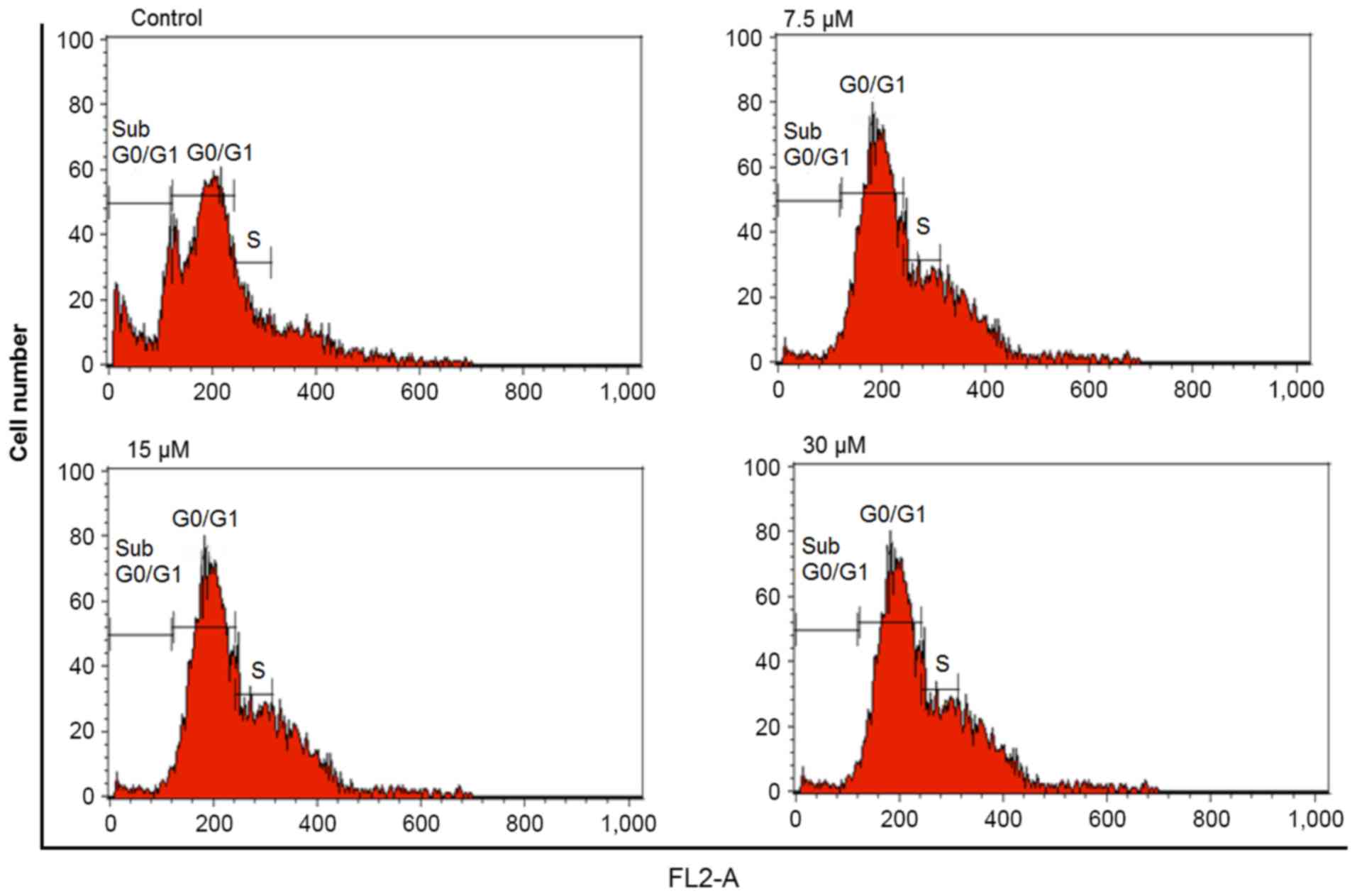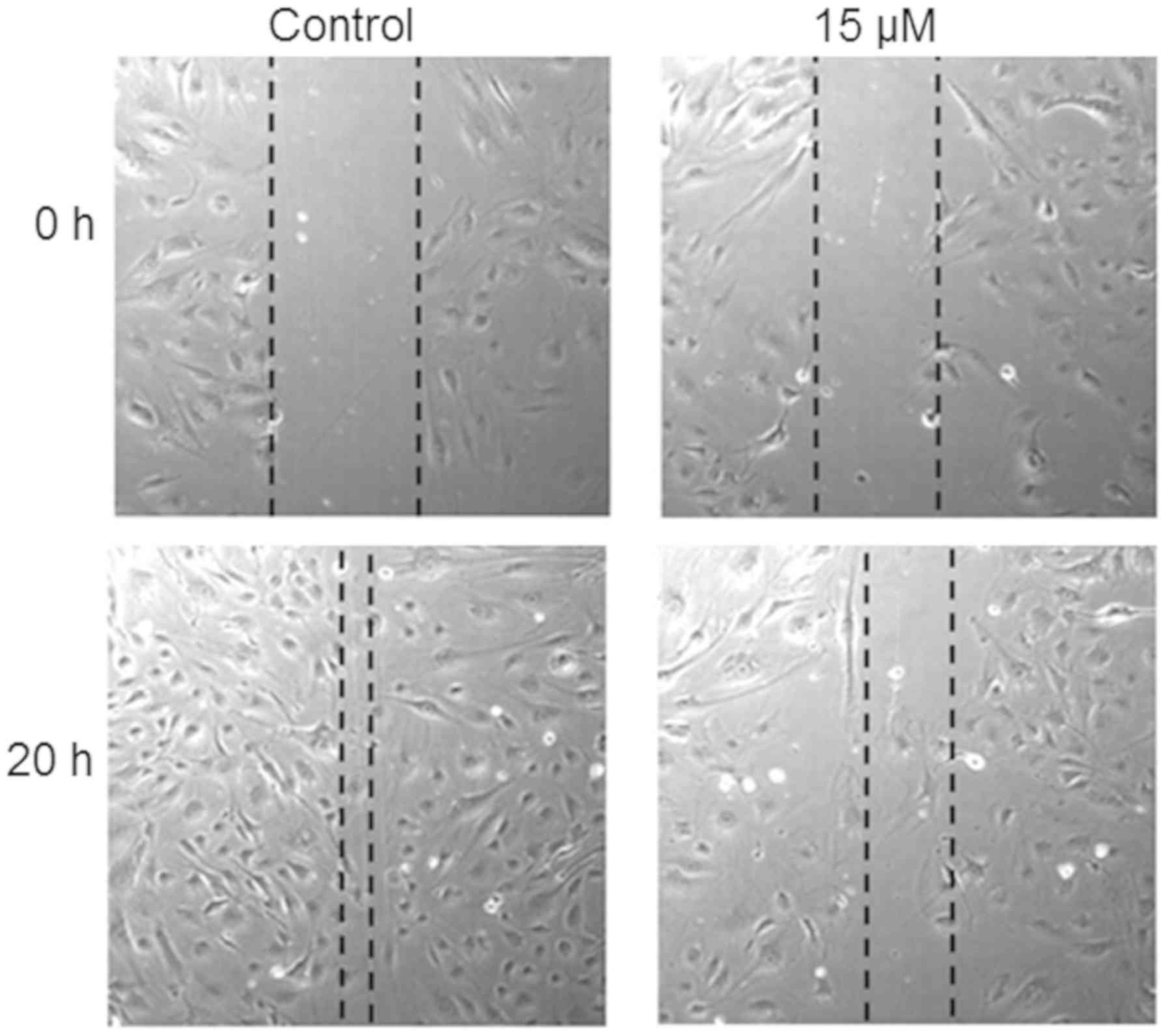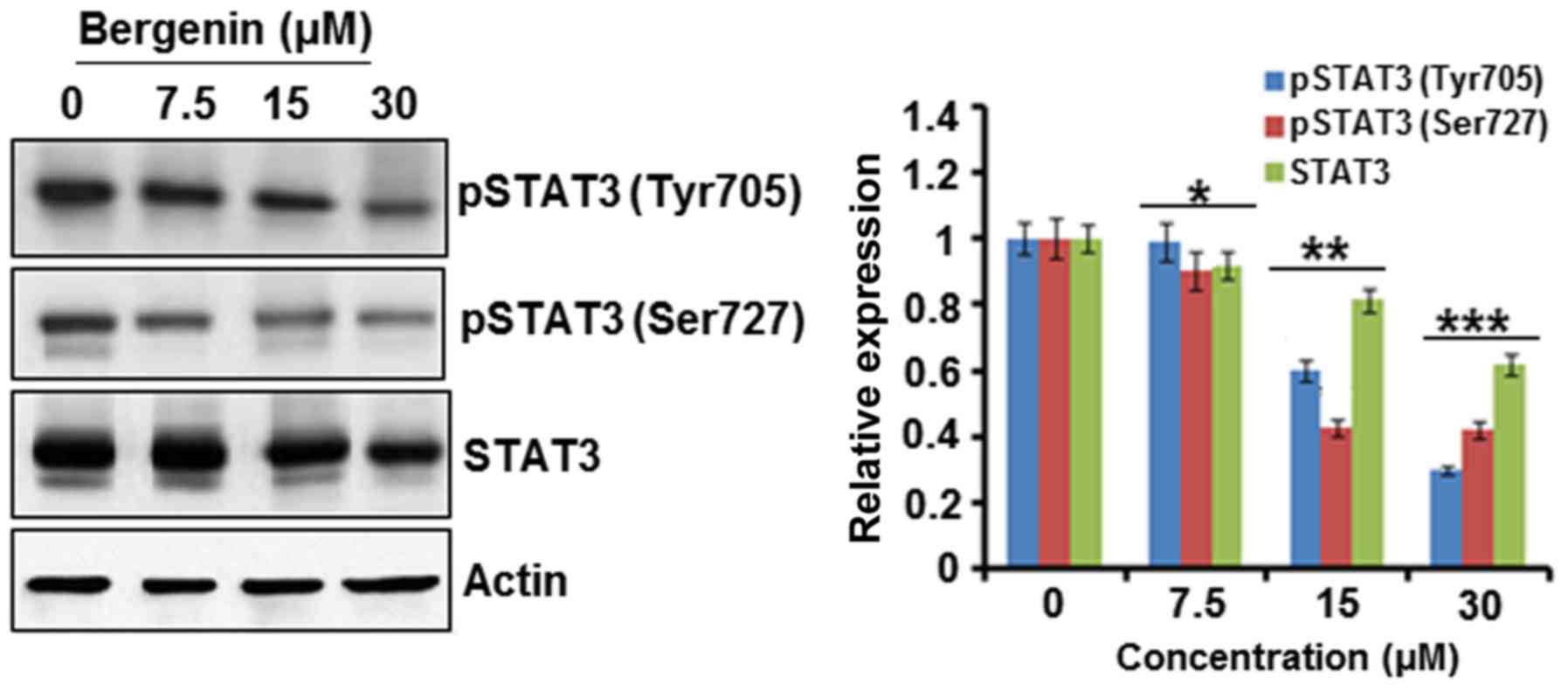Introduction
Cervical cancer one of the most frequently detected
cancers in women around the globe and ranks third among all the
cancers diagnosed in women. Approximately 0.5 million patients are
diagnosed for this lethal type of cancer that is almost 9% of all
the new cancer cases diagnosed annually (1). Although, the currently used treatment
options such as chemotherapy, radical hysterectomy and radiotherapy
have shown promising outcomes, approximately 0.3 millions deaths
still occur due to cervical cancer annually (2). For the early stage cervical cancers
mainly involves office-based ablative therapies. Cold-knife
conization or electroconization is performed in most of the
patients to exclude invasive disease. Furthermore, surgery followed
by chemotherapy is recommended for patients with advanced stage
cervical cancer (2). However the
chemotherapeutic agents exhibit adverse effect that compromise the
health of the patients and as such Therefore, to there is an urgent
need to identify novel molecules that could prove efficient in the
treatment of cervical cancer with minimal side effects (3).
The molecules derived from plants are considered
prospective anticancerous agents and are therefore being screened
for their anticancer activity every now and then. Bergenin is
considered as one of the rare acylated iridoid glucosides isolated
from some species of Bergenia (4,5). It has
been reported to exhibit a diversity of pharmacological properties.
Recently it was found to exhibit significant pharmacological
activities such as anticancer (6).
However, the anticancer activity of bergenin against cervical
cancer cells has not been evaluated so far. In the present study we
evaluated the anticancer effects of bergenin against cervical
cancer cell line HeLa and normal cervical cell line HCerEpiC. In
this study we report that bergenin inhibits the proliferation of
cervical HeLa cancer cells. The anticancer effects are mainly due
to the induction of apoptosis and cell cycle arrest in the G0/G1
phase. Moreover, bergenin exhibited the capacity to inhibit the
migration of the HeLa cells. The effects of bergenin were also
evaluated on the STAT3 signalling pathway (7). It was observed that bergenin inhibited
the phosphorylation of STAT3 proteins. Taken together, this study
reveals that bergenin is an important candidate for the treatment
of cervical cancer.
Materials and methods
Chemicals, reagents and culture
conditions
All the chemicals and reagents that were used in the
present study were obtained from Sigma-Aldrich, Merck KGaA,
Darmstadt, Germany. Bergenin (95% purity by HPLC, CAS no.:
477-90-7) was obtained from Sigma-Aldrich, Merck KGaA. Primary and
secondary antibodies were purchased from Santa Cruz Biotechnology
Inc., Dallas, TX, USA. Human cervical cancer HeLa and non-cancerous
human cervical epithelial cells (HCerEpiC) cell lines were
purchased from Type Culture Collection of Chinese Academy of
Sciences, Shanghai, China. The cells were cultured in RPMI-1640
medium containing 10% fetal bovine serum, penicillin and
streptomycin (100 U/ml each) and maintained in a humidified
atmosphere containing 5% CO2.
MTT
(3-(4,5-dimethylthiazol-2-yl)-2,5-diphenyltetrazolium bromide)
assay for cell viability
The cell viability was assessed by MTT assay.
Briefly, the HeLa and HCerEpiC cells were cultured in a 96-well
plates at the density of 5×103 cells/well at 37°C for 24
h. The cells were incubated for one night and then the medium was
removed and replaced with a new medium with bergenin (Dissolved in
10% DMSO) at different concentrations (0–200 µM) for a time period
of 24 h at 37°C. The untreated cells were treated with 10% DMSO.
Thereafter, an MTT solution of the concentration of 0.5 mg/ml for
the last 4 h of incubation and finally the absorbance was measured
at 570 nm.
Apoptosis assays: Cervical cancer HeLa cells were
seeded at the density of 2×105 cells/well in 6-well plates. The
cells were then administrated with 0, 7.5, 15 and 30 µM of bergenin
and incubated for a time period of 24 h. DAPI
(4′,6-diamidino-2-phenylindole, dihydrochloride) staining was
carried by incubating the cells in 6-well plates with DAPI. The
cells were then washed with PBS, fixed in formaldehyde (10%) and
then again washed with PBS. The DAPI stained cells were then
examined by fluorescence microscope (10 fields). For estimation of
apoptotic cell populations, similar procedure was carried out
except for the cells were stained with Annexin V/PI staining and
analysed by flow cytometer.
Analysis of cell cycle
In order to estimate the number of cells in phase of
the cell cycle, the bergenin treated HeLa cervical cancer cells
were harvested and washed with PBS. Thereafter the cells were fixed
with ethanol (70%) for approximately an hour and then washed again
by PBS. The cells were finally resuspended in solution of propidium
iodide (PI) (50 µl/ml) and RNase1 (250 µg/ml). This was followed by
incubation for a period of 30 min at room temperature and final
investigation under a fluorescence-activated cell sorting
cater-plus cytometer using 10,000 cells/group.
Cell migration assay
The cell migration potential of bergenin treated
cervical cancer HeLa cells was investigated by wound healing assay.
Briefly 5×104 cells/well were seeded in 96-well plates.
Afterwards the plates were incubated overnight at 37°C to allow the
cells to adhere. Then a wound was scratched using a sterile pipette
tip after the cells reached confluence. The cells were then washed
with PBS to clear the detached cells. The cells were monitored
after 20 h interval and photographed.
Western blotting analysis
Total protein from untreated and bergenin treated
HeLa cervical cancer cells was isolated in RIPA lysis buffer and
the protein concentrations were determined by BCA assay. Equal
volumes of the proteins from each sample were run on SDS PAGE. This
was followed by then transference to a polyvinylidene fluoride
membrane. Afterwards, blocking was done with 5% non-fat milk
followed by an incubation at RT for 1 h. The membranes were then
subjected to treatment either specific primary antibody (STAT3;
cat. no. sc-293151, p-STAT3 (Ser 727); cat. no. sc-8001-R, p-STAT
(Tyr705); cat. no. sc-7993-R, Bax; cat. no. sc-20067, Bcl-2;
sc-509, Actin; sc-58673 purchased from Santa Cruz Biotechnology
Inc.) at 4°C for 20 h. Thereafter, washing in washing buffer was
carried out and then the membranes were incubated with secondery
antibody (mouse monoclonal secondary antibody conjugated to
Horseradish Peroxidase, cat. no. sc-2357) for 1 h. The protein
bands were then visualised by an ECL Advanced Western Blot
Detection kit.
Statistical analysis
The experiments were carried out thrice and the
values represent mean of the three replicates ± SD. Student's test
(For comparisons between two groups) and One way ANOVA followed by
Tukey's test (for comparison between more than two samples) was
used for statistical analysis using GraphPad prism software 7. The
values were considered significant at *P<0.01, *P<0.001,
*P<0.0001.
Results
Bergenin decreases the viability of
HeLa cervical cancer cells
The effects of bergenin on cell viability were
assessed by MTT assay. The HeLa cells were subjected to bergenin
(Fig. 1) treatment at varied
concentrations (0, 7.5, 15 and 30 µM). The outcomes of MTT assay
showed that bergenin exhibited significant antiproliferative
effects on the HeLa cells and the antiproliferative effects were
found to be concentration dependent (Fig. 2). It was found that the
IC50 of bergenin against HeLa cervical cancer cells was
15 µM as compared to its IC50 of 75 µM against
non-cancerous HCerEpiC cells. These results unequivocally show that
bergenin selectively exerts anticancer effects on cervical cancer
cells.
Bergenin induces apoptosis in HeLa
cervical cancer cells
In this study we assessed that if bergenin triggers
apoptosis in HeLa cervical cancer cells. The HeLa cervical cancer
cells were first treated with bergenin at different concentrations,
and then subjected to DAPI staining and finally observed under
fluorescence microscope. It was observed that bergenin induced
apoptosis in HeLa cervical cancer cells as evident from the
increased number of cells with white colour nuclei (Fig. 3). The results of Annexin V/PI further
revealed that the apoptotic cell populations increased from 4.12%
in control to 62.16% at 30 µM concentration (Fig. 4). To further confirm the apoptosis at
molecular level, we determined the expression of Bax and Bcl-2
proteins. The results showed that bergenin treatment increased the
expression of Bax and decreased the expression of Bcl-2 in a
concentration dependent manner (Fig.
5).
Bergenin causes G0/G1 cell cycle
arrest in HeLa cervical cancer cells
The distribution of HeLa cervical cancer cells in
the different cell cycle phases after treatment with bergenin at
varied concentrations was determined by flow cytometery. The
results showed that bergenin lead to the accumulation of HeLa
cervical cancer cells in G0/G1 phase of the cell cycle and
ultimately prompting G0/G1 cell cycle arrest (Fig. 6).
Bergenin inhibits cell migration of
HeLa cervical cancer cells
The effects of bergenin at IC50 were
determined on the migration of HeLa cervical cancer cells by wound
healing assay. The results showed that bergenin significantly
inhibited the migration of the HeLa cervical cancer cells (Fig. 7).
Bergenin inhibits STAT3 signalling
pathway
STAT3 signalling pathway has been found to be
involved the progression and tumorigenisis of different types of
cancers (7). In the present study,
the effect of bergenin was also investigated on STAT3 signalling
pathway. It was observed that bergenin inhibited the
phosphorylation of STAT3 proteins in a concentration dependent
manner and also decreased the expression of STAT3 (Fig. 8).
Discussion
Cervical cancer is one of the lethal and frequently
detected cancers around the world. In the recent past the incidence
of cervical has increased significantly and is expected to increase
in future (8,9). The current treatment strategies are
limited and are associated with lot of side effects (6,10).
Therefore, there is an urgent need to look for strong and novel
therapeutic targets to curb the growing incidence of the cervical
cancer. Over the years plant derived secondary metabolites have
attained considerable attention as bioactive molecules. They have
been shown to exhibit anticancer activity against a range of cancer
types (11). In this connection, the
present study was carried out to investigate the anticancer effects
of bergenin against cervical HeLa cancer cells. The results showed
that bergenin exhibits considerable anticancer activity with an
IC50 of 15 µM against HeLa cervical cancer cells as
compared to IC50 of 75 µM against normal HCerEpiC
cervical cells, suggesting lower toxicity of bergenin against the
normal cells. To further unveil the reasons behind the anticancer
effects of bergenin we carried out DAPI staining and it was
observed that bergenin exerted anticancer effects via induction of
apoptosis. Moreover, the apoptotic effects of bergenin were
concentration dependent and the apoptotic cell populations
increased with increased concentration of the bergenin as obvious
from the Annexin V/PI staining. Apoptosis includes a form of cell
death by which programmed series of actions lead to exclusion of
cells from the body without release of any harmful chemicals. It an
important mechanism by which several of the chemotherapeutic drugs
exert their anti-proliferative molecules (12). The results of the present study are
well supported with previous studies wherein plant derived
molecules have been reported to trigger apoptosis in cancer cells
(11). Next to understand if the
bergenin-induced apoptosis follows mitochondrial pathway, we
estimated the expression of Bax and Bcl-2 proteins. The results of
the western blotting revealed that the expression of Bax was
increased and that of Bcl-2 was decreased in response to the
bergenin treatment. Another important mechanism that has been
reported to contribute to the anticancer effects of many well known
drugs is the cell cycle arrest (13). Some anticancer drugs halt the
progression of the cells from one phase of the cell cycle to other
by targeting specific proteins leading to the accumulation of the
cancer cells at a particular stage. Arrest of the cell cycle
prevents the cancer cell to develop into tumours and to spread to
other parts of the body (14).
Consistent with this, we observed that bergenin caused G0/G1 cell
cycle arrest of HeLa cervical cancer cells in a concentration
dependent manner. Anticancer agents that inhibit the migration of
the cancer cells have been reported to of importance as they may
efficiently inhibit the metastasis of the cancer cells (15). In the present study we also observed
that bergenin could efficiently inhibit the migration of HeLa
cancer cells. Earlier it was reported that many anticancer
molecules target STAT3 signalling pathway in cancer cells (16). It was observed that bergenin enhanced
decreased the expression of STAT3 indicating that the anticancer
effects of bergenin may in part be due to inhibition of STAT3
signalling pathway.
In conclusion bergenin shows considerable anticancer
effects against human cervical cancer cells. The anticancer
activity is mainly due to the induction of apoptosis, cell cycle
arrest and inhibition of STAT3 signalling pathway. The results of
the present study indicate that bergenin may prove to be a
promising lead molecule for the treatment of cervical cancer and
deserves in vivo evaluation.
Acknowledgements
Not applicable.
Funding
No funding was received.
Availability of data and materials
The datasets used and/or analyzed during the current
study are available from the corresponding author on reasonable
request.
Authors' contributions
XS and TZ were involved in drafting the manuscript.
XS designed the study. XS, MX, KL, WH and HY collected and analyzed
the data. XS, MX and TZ interpreted the data and collected the fund
for this study and gave final approval of the version to be
published. All authors reviewed the initial manuscript and revised
it critically for important intellectual content.
Ethics approval and consent to
participate
Not applicable.
Patient consent for publication
Not applicable.
Competing interests
The authors declare that they have no competing
interests.
References
|
1
|
Brinton LA: Epidemiology of cervical
cancer-overview. IARC Sci Publ. 3–23. 1992.PubMed/NCBI
|
|
2
|
Franco EL, Duarte-Franco E and Ferenczy A:
Cervical cancer: Epidemiology, prevention and the role of human
papillomavirus infection. CMAJ. 164:1017–1025. 2001.PubMed/NCBI
|
|
3
|
Smith JS, Lindsay L, Hoots B, Keys J,
Franceschi S, Winer R and Clifford GM: Human papillomavirus type
distribution in invasive cervical cancer and high-grade cervical
lesions: A meta-analysis update. Int J Cancer. 121:621–632. 2007.
View Article : Google Scholar : PubMed/NCBI
|
|
4
|
Lan-ju JI: Bergenin HPLC determination of
two species of bergenia growing in tibet. Acta Botanica
Boreali-occidentalia Sinica. 2:312005.
|
|
5
|
Singh DP, Srivastava SK, Govindarajan R
and Rawat AKS: High-performance liquid chromatographic
determination of bergenin in different Bergenia species. Acta
Chromatographica. 19:246–252. 2007.
|
|
6
|
Gao X, Wang Y, Zhang J, Lin L, Yao Q and
Xiang G: Bergenin suppresses the growth of colorectal cancer cells
by inhibiting PI3K/AKT/mTOR signaling pathway. Trop J Pharm Res.
16:2307–2313. 2017.
|
|
7
|
Yu H, Pardoll D and Jove R: STATs in
cancer inflammation and immunity: A leading role for STAT3. Nat Rev
Cancer. 9:798–809. 2009. View
Article : Google Scholar : PubMed/NCBI
|
|
8
|
Jemal A, Bray F, Center MM, Ferlay J, Ward
E and Forman D: Global cancer statistics. CA Cancer J Clin.
61:69–90. 2011. View Article : Google Scholar : PubMed/NCBI
|
|
9
|
Patel S, Gheewala N, Suthar A and Shah A:
In-vitro cytotoxicity activity of Solanum nigrum extract against
Hela cell line and Vero cell line. Int J Pharm Pharmaceutic Sci.
1:38–46. 2009.
|
|
10
|
Kini S and Swain SP: Synthesis and
evaluation of novel benzothiazole derivatives against human
cervical cancer cell lines. Indian J Pharm Sci. 69:462007.
View Article : Google Scholar
|
|
11
|
Aadil K, Rather MA and Rashid R:
Plant-based natural compounds and herbal extracts as promising
apoptotic agents: Their implications for cancer prevention and
treatment Adv. Biomed Pharma. 3:245–269. 2016.
|
|
12
|
Fisher DE: Apoptosis in cancer therapy:
Crossing the threshold. Cell. 78:539–542. 1994. View Article : Google Scholar : PubMed/NCBI
|
|
13
|
Evan GI and Vousden KH: Proliferation,
cell cycle and apoptosis in cancer. Nature. 411:342–348. 2001.
View Article : Google Scholar : PubMed/NCBI
|
|
14
|
Waldman T, Zhang Y, Dillehay L, Yu J,
Kinzler K, Vogelstein B and Williams J: Cell-cycle arrest versus
cell death in cancer therapy. Nat Med. 3:1034–1036. 1997.
View Article : Google Scholar : PubMed/NCBI
|
|
15
|
Jones DH, Nakashima T, Sanchez OH,
Kozieradzki I, Komarova SV, Sarosi I, Morony S, Rubin E, Sarao R,
Hojilla CV and Komnenovic V: Regulation of cancer cell migration
and bone metastasis by RANKL Nature 440. 692–346. 2006.
|
|
16
|
Yu H, Lee H, Herrmann A, Buettner R and
Jove R: Revisiting STAT3 signalling in cancer: New and unexpected
biological functions. Nat Rev Cancer. 14:736–746. 2014. View Article : Google Scholar : PubMed/NCBI
|















